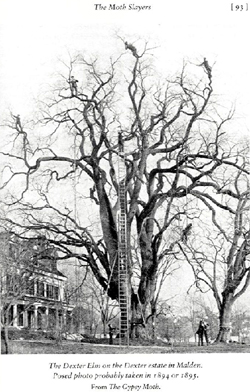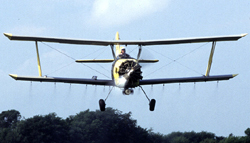
Fighting The Gypsy Moths
This section provides some information on efforts over the years to rid the country of gypsy moths.
Spraying Insecticide in 1891
Finding and destroying
egg masses
Wrapping trees with burlap
More powerful sprayers
Aerial Spraying
Gypsy Moth Wars
Following their escape from Mr. E. Leopold Trouvelot's property in 1869, gypsy moths became an annoyance, then a bother, then a major problem when in the spring of 1889, the population of gypsy moths exploded in Medford, Massachusetts. The problem was so bad that the State of Massachusetts stepped in and appropriated funds to fight the gypsy moth. Economic entomologists thought that they could eradicate the gypsy moths, and promised to do so. Attempts to fight them included spraying insecticide, finding and destroying egg masses, cutting and burning trees, and banding trees with burlap. Pictures of some of these activities are shown in the pictures on the right.
The main insecticides used during these times were Paris Green and Lead Arsenate. These were not very effective and there were concerns of safety and contamination. There was also dissatisfaction with the widespread damage caused by the cutting and burning of trees, and with the harm done to any possible natural enemies, including birds. Surprisingly, one of the most effective means of decreasing the gypsy moth's numbers was the banding of trees with burlap. At times they had wrapped 2,500,000 trees with burlap and had a team of 570 men re-visiting them each day to collect and destroy caterpillars found hiding under the burlap.
After 11 years of trying to eradicate the moths, they were still around and in fact had spread over a much wider area. In 1901, Massachussets State funding was stopped as the promised results from the eradication efforts failed to be realized.
Detailed descriptions of the gypsy moth wars fought in Massachusetts from 1890 to 1901 are provided in ref. 4.
By 1905 the gypsy moths were found in the states of New Hampshire, Maine, Rhode Island, and Connecticut. As the problem now encompassed many states, the Federal Government became involved. In 2005 Federal funding was approved to fight the gypsy moth.
The federally supported programs also involved spraying lead arsenate. However, by then more powerful spraying equipment had been developed that could spray higher into a tree. Also, efforts were pursued to find natural enemies of the gypsy moth. Forty different parasites were tried, most imported from other countries. Few if any helped the gypsy moth problem, and some attacked beneficial insects. Efforts to introduce a fungus deadly to the gyspy moth were also pursued, but the results were disappointing. The government also set up inspection and quarantine programs to try to stem the spread of the gypsy moths. These programs were unsuccessful.
Despite the expenditure of significant amounts of Federal funds, the territory infested by gypsy moths continued to expand. By the start of the World War I, gypsy moths in Massachussets were found in an area of more than 2,500 square miles, and by then were also in New York.
After World War II, DDT became available, and aerial spraying of DDT from airplanes was used to spray gypsy moths. DDT worked better than Lead Arsenate, and aerial spraying was more effective than spraying from the ground. DDT was later found to harm the environment and its use was discontinued.
Aerial spraying is still used to spray gypsy moths by state and local government programs, but with limited success.
After over a century of trying to wipe out the gypsy moth, it is still here. If over a century of governmental-supported programs haven't gotten rid of them, the lesson to be learned is that you can't depend on the government to protect your property from gypsy moths. Yes, they might spray, and it might do some good. However, you better also work to combat them. There are things you can do. These are described in the Control section of this website. Some of these methods take work and time, but you can make a difference, and may be able to save your trees.




